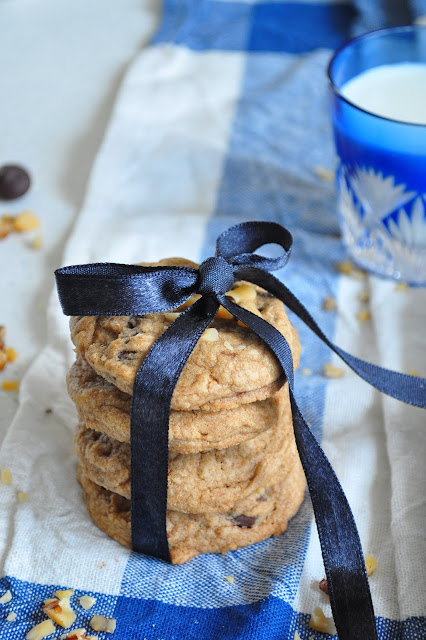You must be now thinking that I've gone macaron crazy. This is the third macaron post this month!
I'm still waiting for Pierre Herme's Macaron book to be delivered to me since ordering it on amazon.com a few weeks ago. Can't promise that there won't be more macaron posts in January but I think I should try and divert my attention to something else since I'm piling up too many egg yokes in the fridge.
Some friends have asked why I keep making these bite-size macarons instead of the larger ones more commonly sold by pastry shops. I think its because I find it more appealing being able to pop a whole macaron into my mouth at one go... Or it could also be that my first macaron experience were the luxemburgelis sold by Confiserie Sprüngli in Switzerland. Luxemburgelis are smaller with very smooth and high dome-shaped shells.
The basil buttercream pairs well with cocoa shells (with and without cacao nibs topping) and taste distinctly of basil - its a sweet cream with herbal notes.
This should be my last post for 2011. Here's wishing everyone a Happy New Year! And a great 2012 ahead!
Recipe below makes around 20 sandwiched macarons
(Adapted from Les Petit Macaron by Kathryn Gordon and Anne E. McBride)
72g almond flour
72g confectioners' sugar
12g cocoa powder
58g egg whites
1 tsp egg white powder
1 tsp egg white powder
1/4 tsp cream of tartar
75g granulated sugar
28.5g water
1 tbls cacao nibs for topping half of the shells (optional)
Place almond flour, confectioners' sugar and cocoa powder in food processor and
pulse for about 40 seconds to combine them into fine powder. Sift
through a fine-mesh strainer into a large
mixing bowl.
While preparing the sugar syrup, whisk egg whites, egg white powder and cream of tartar using an electric mixer on medium speed till soft peaks form. Switch the speed down if egg whites are at soft peaks before syrup is ready.
Heat granulated sugar and water in a small saucepan over medium to high heat. Stir only at beginning to dissolve the sugar crystals. Use a thermometer to measure the syrup, cooking the sugar till it reaches 118C. Carefully pour the sugar syup into the mixer bowl while running the whisk at medium speed. Continue whisking till stiff peaks form and the meringue has cooled down and is glossy.
Transfer the meringue into the large mixing bowl with the dry ingredients. With a rubber spatula, fold in the meringue, folding till the batter is loose enough to drip down from the spatula back to the bowl in one continuous lava-like flow.
Pipe batter onto silicon mat placed on baking sheet. Top half of the shells with cacao nibs before placing into 65C preheated oven for 15 minutes. Without removing the macarons, increase the oven temperature to 150C and bake for another 15 minutes (note that I'm using a convection oven).
Slide silicon mat off baking sheet to cool. Wait for macarons to cool before removing macarons from silicon mat.
Fill with basil buttercream.
Basil buttercream:
15g basil leaves
86g water
86g water
100g granulated sugar
1 1/2 egg whites
pinch of cream of tartar
pinch of fine sea salt
115g unsalted butter, cut into small cubes
1 1/2 egg whites
pinch of cream of tartar
pinch of fine sea salt
115g unsalted butter, cut into small cubes
Whisk egg whites, egg white powder and cream of tartar
using an electric mixer on medium speed till soft peaks form. At the same time, heat basil sugar mixture in a small saucepan over medium to high
heat. Use a
thermometer to measure the syrup, cooking the basil sugar mixture till it reaches 118C. Carefully pour the
sugar syup into the mixer bowl with egg whites while running the whisk at medium speed.
Continue whisking till stiff peaks form and the meringue has cooled down and is glossy. Add salt and butter into meringue and continue to whisk on high speed till mixture becomes smooth and fluffy.
Note: If meringue and butter doesn't combine and mixture starts to look like scrambled eggs, don't despair, and don't throw away the mixture! Chill the mixer bowl and whisk in fridge for about 15 minutes before whisking it at medium speed till the buttercream is formed - it may take a long time (e.g. up to half hour) but the buttercream will come. Trust me! It may be helpful to add some additional butter (a few cubes).
Note: If meringue and butter doesn't combine and mixture starts to look like scrambled eggs, don't despair, and don't throw away the mixture! Chill the mixer bowl and whisk in fridge for about 15 minutes before whisking it at medium speed till the buttercream is formed - it may take a long time (e.g. up to half hour) but the buttercream will come. Trust me! It may be helpful to add some additional butter (a few cubes).



















































